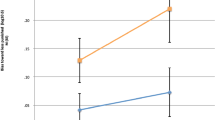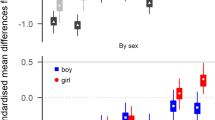Abstract
The attentional performance, activity, and off-task behavior of hyperactive boys with and without conduct problems and normal boys were compared on a cancellation task under three conditions: when performing the task alone, with mother present, and with experimenter present. Results indicated that both the hyperactive groups achieved poorer attentional scores than normal subjects in the alone and mother present conditions, but improved in the experimenter present condition. The performance of the hyperactive boys with conduct problems was particularly affected by this condition. The activity and off-task behavior scores of both the hyperactive groups were higher than controls in all conditions, although the hyperactive boys with conduct problems decreased in off-task behavior when the experimenter was present. Attention and behavior scores were not significantly correlated. The implications of these findings for assessment of hyperactivity, and the role of noncompliance in the attentional behavior of hyperactive children, are discussed.
Similar content being viewed by others
References
Aman, M. G., & Tubbot, S. H. (1986). Incidental learning, distraction, and sustained attention in hyperactive and control subjects.Journal of Abnormal Child Psychology, 14, 441–455.
American Psychiatric Association. (1987).Diagnostic and statistical manual of mental disorders (3rd. ed. revised). Washington DC: Author.
August, G. J., & Garfinkel, B. D. (1989) Behavioral and cognitive subtypes of ADHD.Journal of the American Academy of Child & Adolescent Psychiatry, 28, 739–749.
Barkley, R. A. (1981).Hyperactive children: A handbook for diagnosis and treatment. New York: Guilford Press.
Barkley, R. A. (1990). The problem of stimulus control and rule governed behavior in attention deficit disorder with hyperactivity. In L. Swanson & L. Bloomingdale (Eds.),Emerging trends in research in attention deficit disorder (Vol. IV). New York: Pergamon Press.
Barkley, R. A., McMurray, M. B., Edelbrock, C. S., & Robbins, K. (1989). The response of aggressive and non-aggressive ADHD children to two doses of methylphenidate.Journal of the American Academy of Child & Adolescent Psychiatry, 28, 873–888.
Chee, P., Logan, G., Schachar, R., Lindsay, P., and Wachsmuth, R. (1989). Effects of event rate and display time on sustained attention in hyperactive, normal and control children.Journal of Abnormal Child Psychology, 17, 371–391.
Draeger, S., Prior, M., & Sanson, A. (1986). Visual and auditory attention performance in hyperactive children: Competence or compliance?Journal of Abnormal Child Psychology, 14, 411–424.
Gomez, R., & Sanson, A. V. (1994). Mother-child interactions and noncompliance in hyperactive boys with and without conduct problems.Journal of Child Psychology and Psychiatry, 33, 477–490.
Halperin, J. M., Newcorn, J. H., Sharma, V., Healy, J. M., Wolf, L. E., Pascualvaca, D. M., & Schwartz, S. (1990). Inattentive and noninattentive ADHD children: Do they constitute a unitary group?Journal of Abnormal Child Psychology, 18, 437–449.
Jastak, S., & Wilkinson, G. S. (1984).Wide Range Achievement Test-Revised administration manual. Wilmington, DE: Jastak Associates.
Klorman, R., Brumaghim, J. J., Salzman, L. F., Strauss, J., Borgstedt, A. D., McBride, M. C., & Loebs, S. (1988). Effect of methylphenidate on attention-deficit hyperactive disorder with and without aggression/noncompliant features.Journal of Abnormal Psychology, 97, 413–422.
Koriath, U., Gualtieri, C. T., Van Bourgondein, M. E., Quade, D., & Werry, J. S. (1985). Construct validity of clinical diagnosis in pediatric psychiatry: Relationship among measures.Journal of the American Academy of Child and Adolescent Psychiatry, 24, 429–436.
McGee, R., Williams, S., Bradshaw, J., Chapel, J. L., Robins, A., & Silva, P. A. (1983). The Rutter Scale for completion by teachers: Factor structure and relationships with cognitive abilities and family adversity for a sample of New Zealand children.Journal of Child Psychology and Psychiatry, 26, 727–739.
McGee, R., Williams, S., & Silva, P. A. (1984a). Background characteristics of aggressive, hyperactive, and aggressive-hyperactive boys.Journal of the American Academy of Child Psychiatry, 23, 280–284.
McGee, R., Williams, S., & Silva, P. A. (1984b). Behavioral and developmental characteristics of aggressive, hyperactive, and aggressive-hyperactive boys.Journal of the American Academy of Child Psychiatry, 23, 270–279.
Power, T. J. (1993). Contextual factors in vigilance testing of children with ADHD.Journal of Abnormal Child Psychology, 21, 579–593.
Prior, M., & Sanson, A. V. (1986). Attention deficit disorder with hyperactivity: A critique.Journal of Child Psychology and Psychiatry, 27, 307–319.
Roberts, M. A. (1990). A behavioral observation method for differentiating hyperactive and aggressive boys.Journal of Abnormal Child Psychology, 18, 131–142.
Rutter, M. (1967). A children's behavior questionnaire for completion by teachers: Preliminary findings.Journal of Child Psychology and Psychiatry, 8, 1–11.
Schachar, R., Logan, G., Wachsmuth, R., & Chajczyk, D. (1988). Attaining and maintaining preparation: A comparison of attention in hyperactive, normal, and disturbed control children.Journal of Abnormal Child Psychology, 16, 361–378.
Sergeant, J. A., & Van der Meere, J. J. (1989). The diagnostic significance of attentional processing: Its significance for ADDH classification-a future DSM. In T. Sagvolden & T. Archer (Eds.),Attention deficit disorder (pp. 151–165). New Jersey: Erlbaum.
Szatmari, P., Boyle, M. N., & Offord, D. R. (1989). ADDH and conduct disorder: Degree of diagnostic overlap and differences among correlates.Journal of the American Academy of Child & Adolescent Psychiatry, 28, 865–872.
Van der Meere, J. J., Wekking, E., & Sergeant, J. A. (1991). Sustained attention and pervasive hyperactivity.Journal of Child Psychology and Psychiatry, 32, 275–284.
Wechsler, D. (1974).Manual for the Wechsler Intelligence Scale for Children-Revised. San Antonio, TX: Psychological Corporation.
Werry, J. S., Elkind, G. S., & Reeves, J. C. (1987). Attention deficit, conduct disorders, oppositional and anxiety disorders in children: III. Laboratory findings.Journal of Abnormal Child Psychology, 15, 409–428.
Author information
Authors and Affiliations
Additional information
This study is based in part on the first author's Ph.D. thesis in the Department of Psychology, University of Melbourne.
Rights and permissions
About this article
Cite this article
Gomez, R., Sanson, A.V. Effects of experimenter and mother presence on the attentional performance and activity of hyperactive boys. J Abnorm Child Psychol 22, 517–529 (1994). https://doi.org/10.1007/BF02168935
Received:
Issue Date:
DOI: https://doi.org/10.1007/BF02168935




